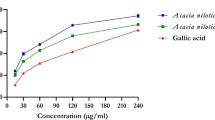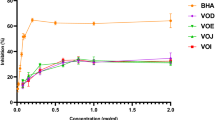Abstract
This study sought to evaluate the antioxidant properties and effects of some edible wild seeds [Afzelia africana Sm. (AFZ), Cyperus esculentus L. (CYP), Eleusine coracana Gaertn. (ELE), Irvingia gabonensis (Aubry-Lecomte ex O’Rorke) Baill. (IRV), Monodora myristica Dunal. (MON) and Parinari curatellifolia Planch. ex Benth. (PAR)] on α-amylase and α-glucosidase activities. The phenolic content and antioxidant activities of aqueous extracts of the seeds as typified by 1,1-diphenyl-2 picrylhydrazyl (DPPH) and hydroxyl (OH) radicals scavenging abilities and inhibition of Fe2+-induced malondialdehyde (MDA) production in rat’s pancreas in vitro were also assessed. ELE had significantly (p < 0.05) higher total phenol content than the other seeds; however, AFZ had the highest flavonoid content. The extracts scavenged DPPH· and OH· in a dose-dependent manner with aqueous extracts of PAR having the highest DPPH· scavenging ability, while extracts from IRV had the highest OH· scavenging ability and inhibition of Fe2+-induced MDA production in rat’s pancreas. Furthermore, all the extracts inhibited α-amylase and α-glucosidase activities in a dose-dependent manner. The α-amylase inhibitory effect of MON (IC50 = 0.48 mg/mL) was comparable to that of acarbose (IC50 = 0.40 mg/mL), while the α-glucosidase inhibitory effect of AFZ (IC50 = 0.45 mg/mL) was comparable to that of acarbose (IC50 = 0.39 mg/mL). The results suggest the potential use of the seeds in the dietary management of blood glucose levels associated with type 2 diabetes.





Similar content being viewed by others
References
Ngondi JL, Oben JE, Minka SR. The effect of Irvingia gabonensis seeds on body weight and blood lipids of obese subjects in Cameroon. Lipids Health Dis. 2005;4:12.
Ngondi JL, Fossouo Z, Djiotsa EJ, Oben J. Glycaemic variations after administration of Irvingia gabonensis seeds fractions in normoglycemic rats. Afr J Trad CAM. 2006;3(4):94–101.
Erukainure OL, Oke OV, Owolabi FO, Kayode FO, Umanhonlen EE, Aliyu M. Chemical properties of Monodora myristica and its protective potentials against free radicals in vitro. Oxid Antioxid Med Sci. 2012;1(2):127–32.
Mathanghi SK, Sudha K. Functional and phytochemical properties of finger millet (Eleusine Coracana L.) for health. I J Pharm Chem Biol Sci. 2012;2(4):431–8.
Banerjee S, Sanjay KR, Chethan S, Malleshi NG. Finger millet (Eleusine coracana) polyphenols: investigation of their antioxidant capacity and antimicrobial activity. Afr J Food Sci. 2012;6(13):362–74.
Ogbonnia SO, Mbaka GO, Anyika EN, Ladiju O, Igbokwe HN, Emordi JE, et al. Evaluation of anti-diabetics and cardiovascular effects of Parinari curatellifolia seed extract and Anthoclista vogelli root extract individually and combined on postprandial and alloxan-induced diabetic albino rats. Brit J Med Medic Res. 2011;1(3):146–62.
Oboh G, Ekperigin MM. Nutritional evaluation of some Nigerian wild seeds. Nahrung/Food. 2004;48(2):85–7.
Chu Y, Sun J, Wu X, Liu RH. Antioxidant and antiproliferative activity of common vegetables. J Agr Food Chem. 2002;50:6910–6.
Amic D, Davidovic-Amic D, Beslo D, Trinajstic N. Structure-related savenging activity relationship of flavonoids. Croat Chem Acta. 2003;76:55–61.
Funke I, Melzig MF. Traditionally used plants in diabetes therapy-phytotherapeutics as inhibitors of α-amylase activity. Brazil J Pharmacog. 2006;16(1):1–5.
Oboh G, Rocha JBT. Polyphenols in red pepper [Capsicum annuum var. aviculare (Tepin)] and their protective effect on some pro-oxidants induced lipid peroxidation in brain and liver. Eur Food Res Technol. 2007;225(2):239–47.
Singleton VL, Orthofor R, Lamuela-Raventos RM. Analysis of total phenols and other oxidation substrates and antioxidants by means of Folin-Ciocaltau reagent. Method Enzymol. 1999;299:152–78.
Meda A, Lamien CE, Romito M, Millogo J, Nacoulma OG. Determination of the total phenolic, flavonoid and proline contents in Burkina Faso honey, as well as their radical scavenging activity. Food Chem. 2005;91:571–7.
Gyamfi MA, Yonamine M, Aniya Y. Free-radical scavenging action of medicinal herbs from Ghana: Thonningia sanguinea on experimentally induced liver injuries. Gen Pharmacol. 1999;32:661–7.
Halliwell B, Gutteridge JMC. Formation of a thiobarbituric-acid-reactive substance from deoxyribose in the presence of iron salts. FEBS Lett. 1981;128:347–52.
Belle NAV, Dalmolin GD, Fonini G, Rubim MA, Rocha JBT. Polyamines reduces lipid peroxidation induced by different pro-oxidant agents. Brain Res. 2004;1008:245–51.
Ohkawa H, Ohishi N, Yagi K. Assay for lipid peroxides in animal tissues by thiobarbituric acid reaction. Ann Biochem. 1979;95:351–8.
Worthington Biochemical Corp. Worthington, enzyme and related biochemicals. Worthington Biochemical Corp., Freehold,N.J. 1978.
Apostolidis E, Kwon YI, Shetty K. Inhibitory potential of herb, fruit, and fungal-enriched cheese against key enzymes linked to type 2 diabetes and hypertension. I Food Sci Emerg Technol. 2007;8:46–54.
Zar JH. Biostatistical analysis. Prentice-Hall, Upper Saddle River, NJ; 1984, p.620.
Oberley LW. Free radicals and diabetes. Free Radical Bio Med. 1988;5:113–24.
Wolff SP. Diabetes mellitus and free radicals. free radicals, transition metals and oxidative stress in the aetiology mellitus and complications. Br Med Bull. 1993;49:642–52.
Baynes JW, Thorpe SR. Role of oxidative stress in diabetic complications (a new perspective to an old paradigm). Diabetes. 1999;48:1–9.
Bayır H, Kochanek PM, Kagan VE. Oxidative stress in immature brain after traumatic brain injury. Dev Neurosci. 2006;28:420–31.
Shim YA, Doo HB, Ahn SBK, Yong-Suk C. Inhibitory effect of aqueous extract from the gall of Rhus chinensis on alpha-glucosidase activity and postprandial blood glucose. J Ethnopharmacol. 2003;85:283–7.
Bischoff H. Pharmacology of alpha-glucosidase inhibition. Eur J Clin Invest. 1994;24:3–10.
Horii S, Fukasse K, Matsua T, Kameda K, Asano N, Masui Y. Synthesis and a-D-glucosidase inhibitory activity of N-substituted valiolamine derivatives as potent oral antidiabetic agents. J Med Chem. 1987;29:1038–46.
Author information
Authors and Affiliations
Corresponding author
Rights and permissions
About this article
Cite this article
Ademosun, A.O., Oboh, G. Inhibition of carbohydrate hydrolyzing enzymes associated with type 2 diabetes and antioxidative properties of some edible seeds in vitro. Int J Diabetes Dev Ctries 35 (Suppl 3), 516–521 (2015). https://doi.org/10.1007/s13410-015-0339-7
Received:
Accepted:
Published:
Issue Date:
DOI: https://doi.org/10.1007/s13410-015-0339-7




